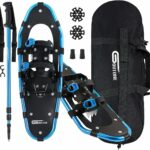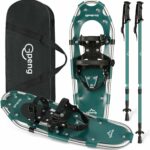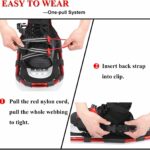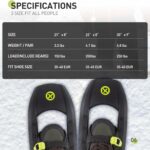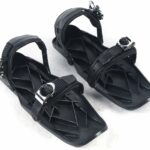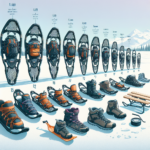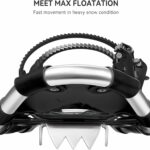Setting out on a wintry wonderland can be an incredible adventure, but you need the right gear to truly enjoy it. Choosing the size of your snowshoes can greatly impact your ability to traverse this snowy spectacle. This article will guide you in making an informed decision so you can confidently confront the harshest of winter weather. With information ranging from the type of snow, your weight, the activity you’ll be participating in, and the terrain you’ll face, it aims to equip you with the knowledge necessary to make the perfect choice. Your icy escapades will never be the same.
Understanding the Basics of Snowshoe Sizing
To make the most of your snowshoeing experience, it’s important to understand the basics of snowshoe sizing. Selecting the correct snowshoe size involves more than just matching it to your regular shoe size. Instead, it has more to do with understanding the principle of flotation, factoring in your weight, and considering the snow conditions.
The principle of flotation
The principle of flotation is about how much weight the snowshoes can support on the snow without sinking too much. Snowshoes distribute your weight across a larger area, making it easier for you to walk on the snow without sinking. So, the larger the snowshoe, the more weight it can support, and the less you’ll sink.
How weight influence size choice
Your weight plays a vital role in determining the right snowshoe size for you. The heavier you are, the larger your snowshoes should be to facilitate appropriate flotation. Remember, weight here doesn’t only mean your body weight – it includes the total weight you’ll be carrying, including clothes and any gear you might be carrying along.
Impact of snow conditions on size
Snow conditions majorly impact the ideal size of the snowshoes. So it’s essential to consider the type of snow you’ll be encountering when picking your shoe size. For deep, soft snow, larger snowshoes are more suitable, ensuring better flotation. On the contrary, smaller sizes are preferable for compact or hard-packed snow.
Understanding the Role of Body Weight
Choosing the right size of snowshoes isn’t just about your shoe size; your body weight plays a critical role too.
Direct correlation between weight and snowshoe size
There’s a direct correlation between your weight and snowshoe size. Essentially, the heavier you are, the bigger your snowshoes need to be. This is due to the principle of flotation, which means bigger snowshoes have a larger surface area to distribute your weight, preventing you from sinking too much into the snow.
Considering total load: body weight plus gear
When we talk about weight, it’s not just your body weight – you also need to factor in the weight of your gear. If you’re carrying a backpack with food, water, or camping equipment, this added weight will affect the sizing of your snowshoes.
Analyzing Snow Conditions
Different snow conditions can vastly influence the type and size of snowshoes you’ll need.
Different sizes for different snow conditions
Different snow conditions require different snowshoes, and therefore, different snowshoe sizes. For instance, if you’re walking on freshly-fallen, powdery snow, you’ll want a larger model that gives you increased flotation. But if you’re trekking on a well-trodden path, a smaller size may be more convenient.
Compact vs powdery snow
Compact or hard-packed snow doesn’t require as much flotation, so you can get away with a smaller snowshoe. On the other hand, you’ll need a larger model for powdery snow to prevent sinking and offer maximum flotation.
Effect of wet and heavy snow
Wet and heavy snow can make snowshoeing more challenging – this type of snow will often require you to use larger snowshoes to provide better flotation.
Considering Terrains and Activity Types
The type of terrain you’re planning to tackle and the activities you wish to engage in will hugely influence the size of your snowshoes.
Variations in size for flat, rolling, and mountainous terrains
For flat terrain, you might be able to use smaller snowshoes for maximum control and maneuverability. For rolling or mountainous terrain, however, larger snowshoes may be more suitable to give you the flotation and traction you need.
Specific sizes for activities: hiking, running, utility
If you’re planning to go snowshoe hiking or backpacking, you’ll need larger snowshoes due to the added weight you’ll be carrying and the potential for encountering deep snow. For snowshoe running, smaller and lighter options are more appropriate, allowing for faster and more efficient movement. Utility snowshoes, primarily used for heavy work, are typically larger and designed for significant weight loads and various snow conditions.
Factoring in the Gender & Age
Manufacturers also take into account the user’s gender and age while designing snowshoes.
Specific designs and sizes for men, women, kids
Men’s, women’s, and kids’ snowshoes vary not only in color but also in size. Men’s models are generally larger and designed to support more weight. Women’s models are typically slightly smaller and with a design that accommodates a narrower stride. Kids’ snowshoes, of course, are much smaller and are meant for lighter weights.
Differences in flexibility, stride length, and load-carrying capacity
There are also fundamental sizing differences based on flexibility, stride length, and load-carrying capacity. Women’s and kids’ snowshoes usually give more flexibility and have a stride length appropriate for shorter gait, whereas men’s snowshoes are meant for longer strides and greater loads.
Understanding the Impact of Shoe and Binding Sizes
The selection of right snowshoe size also takes into account your shoe and binding sizes.
Compatibility of snowshoe and boot size
Your boots need to be compatible with your snowshoes. If your boots are too large for the snowshoe bindings, you’re likely to have difficulty fastening them securely. Conversely, if your boots are too small, they may move around within the bindings, resulting in a less stable footing.
Effects of binding adjustments on snowshoe size
Most snowshoe bindings can be adjusted to accommodate a range of boot sizes. And these adjustments can influence the size and shape of your snowshoe footprint. If the bindings are set too tight or too loose, it could impact how well the shoes float on the snow.
Learning from Snowshoe Size Charts
Size charts provided by manufacturers can be a great guide in selecting the right size snowshoes.
How to read and use size charts
Snowshoe size charts usually list the recommended weight ranges for each size of snowshoe. To use a size chart, just look for your weight (including gear) and see which range it falls into. But remember, these charts are only general guidelines, and individual preference and snow conditions can warrant adjusting up or down from the recommended size.
Importance of consulting manufacturer-specific charts
Different manufacturers may have slightly different sizing conventions, so it’s crucial to consult the size chart specific to the brand of snowshoes you are considering.
Insights from Reviews and Experienced Users
In addition to size charts and your own measures, you can gain valuable insights from reviews and experienced snowshoe users.
Finding reliable review sources
Online reviews, especially those describing people’s personal experiences with specific snowshoe models and sizes, can provide great guidance. Just be sure you’re looking at reliable sources where reviews are honest and unbiased.
Practical sizing advice from experienced snowshoers
Experienced snowshoers can offer practical advice on sizing. For instance, they might suggest going a size larger if you’re frequently in deep, powdery snow or choosing a size smaller if you do a lot of trail running.
Trying Out Different Sizes
Nothing beats trying out different sizes to see what works best for you.
The importance of physical trial
The best way to ensure you get the right size is by trying on the snowshoes. Walk around in them, check if they feel comfortable and offer ample support. Ensure the bindings fit securely, and that the size suits your stride and stability.
Observing comfort and performance in various conditions
Observing the snowshoes’ comfort and performance in various conditions can be highly revealing. Try walking in different types of snow and on varying terrains. This will test how well the snowshoes float and provide traction.
Making the Final Selection
By factoring in all this information, you’re well-equipped to make your final selection.
Balancing all factors
Arriving at the perfect snowshoe size requires balancing various factors. From your weight to snow conditions, from the nature of your activity to the specific dynamics of your gender, age, and shoe size, it’s essential to weigh in on all these factors to uncover the best size for optimal comfort and performance.
Considering durability and other features
Aside from sizing, be sure to take into account other factors, such as durability and additional features. Some models offer heel lifts, which can help reduce calf strain on uphill segments, or additional crampons for improved traction. Such features can influence your final choice.
Fitting snowshoes properly
Once you decide on a size, take the time to ensure the snowshoes fit properly. The binding should securely hold your boot in place without any unwanted movement. Remember, well-fitting snowshoes will ensure a more enjoyable and safer snowshoeing experience.
By understanding these facts about snowshoe sizing, you can confidently choose the right size and enjoy the winter wonderland in comfort!
- What Snowboard Bindings Should I Get? - January 23, 2024
- What Size Screws For Snowboard Bindings? - January 23, 2024
- How To Snowmobile On Water? - January 23, 2024


